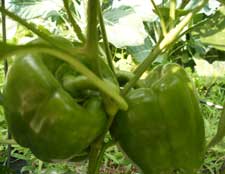Growing Peppers
Peppers are considered a warm season vegetable. There are many varieties of peppers ranging from sweet to hot. One of the oldest and popular garden varieties is the sweet, thick-walled bell pepper ‘California Wonder’.

Starting peppers from seed
Peppers can take 70-90 days to mature therefore, in the colder climates, should be started from seed two months before planting in the garden.
Planted seeds require temperatures of 78-80 degrees and can take 3 weeks to germinate.
Planting peppers
Before setting plants in the garden they need to be “hardened off“. This is done by setting the plants outdoors in a protected area when daytime temperatures are in the 60’s and bringing them inside at night. Gradually increase exposure each day for a week or more. Avoid direct sun and too much wind. When nighttime temps reach 60 degrees and the danger of frost has passed, plant seedlings or store bought plants in full sun (8-10 hrs) spacing 18-24 inches apart. Transplants should be planted at the same depth as grown in their container- too deep can suffocate the roots.
Don’t plant peppers where you previously grew tomatoes, potatoes and eggplant. They all belong in the same Solanaceous family and are susceptible to the same soil borne diseases.
Peppers don’t like cold temperatures. if night temperatures drop below 55 degrees or lower, they will grow very slowly, foliage will turn yellow and the flowers (if any) will drop off.
Care
Peppers prefer a well-drained, rich loamy soil. Use a starter fertilizer such as Quick Start (4-12-4) when transplanting and provide 1 inch of water per week throughout the growing season. Uniform moisture is essential. Overhead watering is not recommended especially when the plants are in bloom as it will wash away the pollen and eliminate fruiting.
Fertilize
Be careful not to apply too much fertilizer as adding too much nitrogen will give you a large leafy plant and no fruit. Once a crop of peppers is set, use an organic fertilizer with a low nitrogen ratio such as 1-3-3.
Hot, dry winds and dry soil prevent fruit set. So, if you live in a region with extremely hot temperatures look for peppers with” TAM” (Texas A&A) or Numex in their names. They were bred to set fruit in temperatures above 100 degrees.
You can also grown peppers in a container and bring it indoors for the winter.
I’ve been growing Cubanella Peppers since last summer, and I’ve grown a ton of peppers throughout the months, but the last few months all the leaves on my plant has fallen off but the peppers continue to grow. Are they safe to eat? The poor plant just looks sick and naked. help!